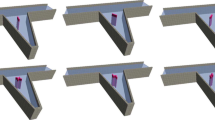Abstract
The air-trapped vertical vortices (ATVVs) are easy to form above the throttled orifices in the widely used long-corridor-shaped surge tanks (LCSSTs), when the tank water level decreases rapidly during hydraulic transients. These ATVVs may jeopardize the operation safety of the hydropower stations and should be avoided. This study elucidates the formation mechanism of the ATVVs and proposes some simple measures to eliminate them. The 3-D CFD model for predicting the ATVVs is validated first by physical model tests in a model tailrace LCSST, and then the formation mechanism is analyzed based on the numerical results. It is shown that the main influence factor for the ATVVs is the critical submergence, which can be reduced by minimizing the velocity circulation around the throttled orifices. Two practical ATVV elimination measures through suppressing the velocity circulation are compared and verified, and the optimized one is recommended.
Similar content being viewed by others
References
Odgaard A. J. Free-surface air core vortex [J]. Journal of Hydraulic Engineering, ASCE, 1986, 112(7): 610–620.
Li H. F., Chen H. X., Ma Z. et al. Experimental and numerical investigation of free-surface vortex [J]. Journal of Hydrodynamics, 2008, 20(4): 485–491.
Nevzat Y., Fikret K. Critical submergence for intakes in open channel flow [J]. Journal of Hydraulic Engineering, ASCE, 1995, 121(12): 900–905.
Nevzat Y., Abdul S. E., Kerem T. Critical submergence for dual rectangular intakes [J]. Journal of Energy Engineering, 2012, 138(4): 237–245.
Chen Y. L., Wu C., Ye M. et al. Hydraulic characteristics of vertical vortex at hydraulic intakes [J]. Journal of Hydrodynamics, 2007, 19(2): 143–149.
Wang Y. K., Jiang G., Liang D. F. Investigation of air-core vortex at hydraulic intakes [J]. Journal of Hydrodynamics, 2010, 22(2): 673–678.
Wang Y. K., Jiang C. B., Liang D. F. Comparison between empirical formulae of intake vortices [J]. Journal of Hydraulic Research, 2011, 49(1): 113–116.
Li S. B. Research on the influencing factors of vortex at hydraulic intakes [D]. Doctoral Thesis, Tianjin, China: Tianjin University, 2009 (in Chinese).
Wu J., Yang J. D. Three-dimensional flow field analysis of erect swirl in strip-shaped and restricted-orifice surge chamber [J]. Water Resources and Power, 2008, (4): 105–107, 168 (in Chinese).
Deng S. Y., Cheng Y. G. Flow characteristics of long corridor-shaped surge tank and elimination of the air-entraining vertical vortices: CFD simulation and analysis [J]. Journal of Hydroelectric Engineering, 2009, 28(4): 131–142 (in Chinese).
Chen Y., Wu C., Wang B. et al. Three-dimensional numerical simulation of vertical vortex at hydraulic intake [J]. Procedia Engineering, 2012, 28: 55–60.
Okamura S., Tomoyoshi T., Kamemoto T. et al. CFD simulation of flow in model pump sumps for detection of vortices [C]. 8th Asian International Fluid Machinery Conference. Yichang, China, 2005, 12–15.
Cai F., Cheng Y. G., Zhang X. X. Approaches to guarantee accurate 3D CFD simulations of surge tank wave [J]. Engineering Journal of Wuhan University, 2016, 49(3): 390–396 (in Chinese).
Xia L. S., Cheng Y. G., Zhou D. Q. 3-D simulation of transient flow patterns in a corridor-shaped air-cushion surge chamber based on computational fluid dynamics [J]. Journal of Hydrodynamics, 2013, 25(2): 249–257.
ANSYS FLUENT 14.0 theory guide [M]. Canonsburg, PA, USA: ANSYS Inc., 2011.
Tang X. L., Wang F. J., Li Y. J. et al. Numerical investigations of vortex flows and vortex suppression schemes in a large pumping-station sump [J]. Journal of Mechanical Engineering Science, 2011, 225(6): 1459–1480.
Keshavarzi G., Guan H. Y., Barber T. Comparison of the VOF and CLSVOF methods in interface capturing of a rising bubble [J]. Journal of Computational Multiphase Flows, 2013, 5(1): 43–56.
Chen Z. N., Wu C., Chen Y. G. et al. Experiment study of vertical vortex at hydraulic intakes [J]. Journal of Southwest University for Nationalities (Natural Science Edition), 2006, 32(4): 799–804 (in Chinese).
Author information
Authors and Affiliations
Corresponding author
Additional information
Project supported by the National Natural Science Foundation of China (Grant No. 51579187).
Biography: Fang Cai (1990-), Female, Master
Rights and permissions
About this article
Cite this article
Cai, F., Cheng, Yg., Xia, Ls. et al. Mechanism of air-trapped vertical vortices in long-corridor-shaped surge tank of hydropower station and their elimination. J Hydrodyn 29, 845–853 (2017). https://doi.org/10.1016/S1001-6058(16)60796-5
Received:
Revised:
Published:
Issue Date:
DOI: https://doi.org/10.1016/S1001-6058(16)60796-5




